Alone and Together (Cooperative and Solo Mode)
2022. August 30.
Hello everyone, I’m back from holiday! But the amazing team at Mindclash did not rest even while I was away, and now the game is almost ready for production. I remember we promised a design spotlight highlighting all the nitty-gritty bits of where the mechanisms of solo/coop ended up, but we’ve been waiting for Ian O’Toole’s wonderful graphics to catch up on the coop-specific components before showing it all to you in one go, and now we’re finally there!
Back in Spotlight #9 before the campaign, we already gave a high-level overview of how the solo/coop of the game works. The good news is that none of this has changed. Also, to stop me from writing “solo and cooperative” whenever I write “coop” in this article, I always mean “solo and coop” unless I explicitly say otherwise.
Thematically, the coop game covers the time after the Voidfall itself, when the Rifts have opened over the heart of the Domineum, and the Voidborn has corrupted the fleets of the Novarchon’s once mighty empire. Players are the leaders of the semi-independent great houses who banded together to defeat this menace and push back the Voidborn’s control over the galaxy. So you play a “normal” game of Voidfall, taking actions the same way as you’ve learned until now (almost every non-pvp-battle specific rule of the competitive game applies without a change to the coop game), making sure that in the end you’ve reduced the Voidborn’s score (calculated based on a various number of factors I’ll explain later) enough, so that even the lowest scoring human player exceeds it.

Three times in the game, you may (often willingly) suffer a Catastrophe - thematically this is when your lines and your resolve buckle, and the enemy punches you somewhere it hurts, but this wound serves as a rallying point to bring back you and your allies stronger. Each Catastrophe increases the final score of the Voidborn you have to beat, but gives precious resources to every player. However if you’re forced to suffer a fourth Catastrophe, you immediately lose the game. This is one of the areas where we’ve greatly improved the UI: Catastrophes used to be tracked by put aside Crisis cards, but as more and more sources of them were enshrined in the rules that had nothing to do with Crisis cards, we realized it would be much cleaner to have custom tokens for them, and spaces for them on the Crisis board.
Talking about the Crisis board, it’s time to reveal the beauty that rolled off Ian’s drawing board:
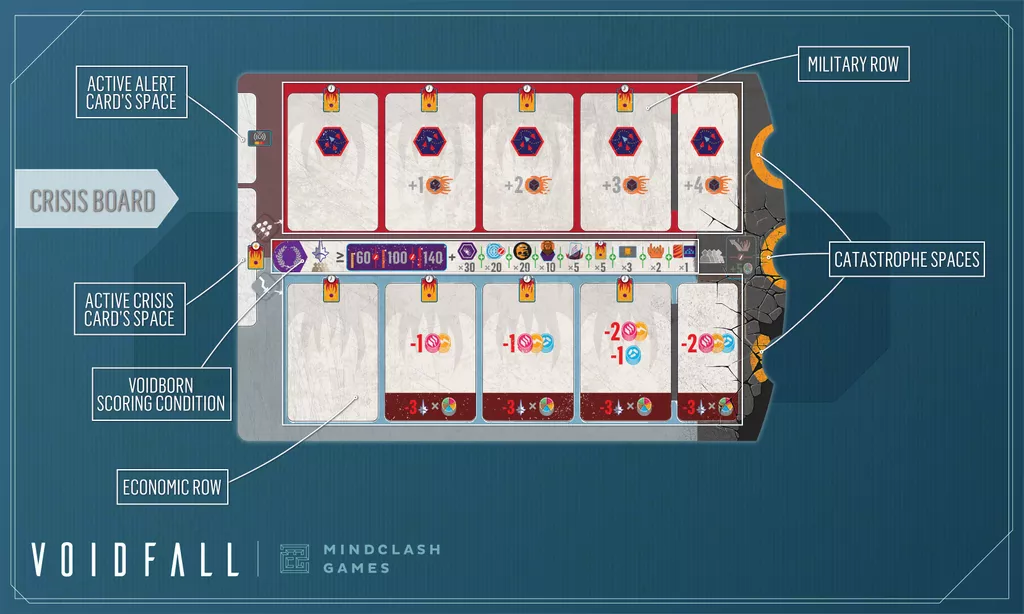
The core concept of the Crisis cards haven’t changed: you get a Crisis on the beginning of your turn, with a condition and a penalty. If anytime during your turn you meet the condition, you discard it. If not, at the end of your turn you either suffer the penalty and discard the card, or you put it on one of the rows, in the leftmost position, pushing every card on that row to the right. (If a card falls off on the right side: catastrophe). Crisis cards can be Economic (must go on the blue row), Military (must go on the red row), or general (your choice). The more cards are on the Military row, the stronger the Voidborn will be at each Skirmish, the more cards are on the blue row, the more resources will be drained from you while the galaxy is in turmoil…
Here comes our first significant gameplay change: We used to have a fourth Crisis card type, War. This one didn’t have a condition, and its penalty always included an unavoidable Skirmish. And overall, we managed to create nice and balanced decks, but in each individual game it often happened that the game “picked on” somebody - every War card seem to be going to the same person, forcing that person constantly to be on the defensive, not the most fun way to play. We experimented with personal Crisis decks for a while (and had component escalation and replayability issues), until we landed on the concept of the Alert deck instead.
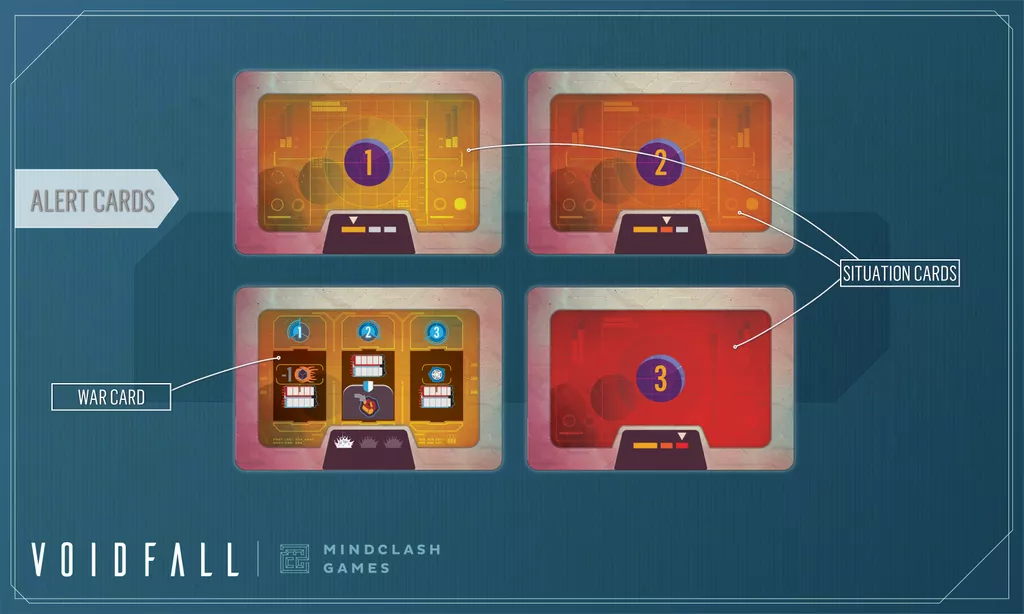
Now the difficulty setting of your game no longer defines the composition of a Crisis deck - the crises are instead shuffled by “level” (i.e. individual relative difficulty) into three draw piles. Instead, the difficulty setting of your game defines the composition of your Alert deck for each Cycle: it’s made up of Situation cards, showing a level between one and three, and War cards, instructing you to resolve the effects of the Military and the Economic track, with some modifiers added, specific to the Cycle the card is being resolved in. At the beginning of each “round”, i.e. before the first player takes each of their turns in the Focus Phase, the group reveals one card from the Alert deck. If for example a Situation 2 card is revealed, every player will be drawing a level 2 Crisis this round; while if a war card is revealed, every player will be facing an attack. This way, the difficulty and the kind of punishment being doled out to players in a multiplayer coop game remains consistent between players.

The second gameplay change is very subtle, but let me tell you this has been the hardest piece of development in a long time (we’ve worked for a month, over 5 or 6 iterations over this one sentence until we found one that worked). The previous system had something called Turmoil payments, where at the end of each of your turns, you had to pay a small amount of resources, increasingly more depending on the number of cards on the Economic track. When we finished the balancing and the streamlining of all the bits of the game a few months ago, we still knew in our hearts that this would be an issue. And final “non-hardcore” user-tests proved us right, the game is big, and requires a lot of mental load, which doesn’t bother people because it all makes sense, and it is all laid out visually in a very good “flow”. However, asking people to also remember to pay a resource or two, that they don’t want to (it’s a penalty), usually it doesn’t matter (except when missing one resource completely ruins your plans), after they have done all the cool things they wanted to do and the next player is eager to take a turn…
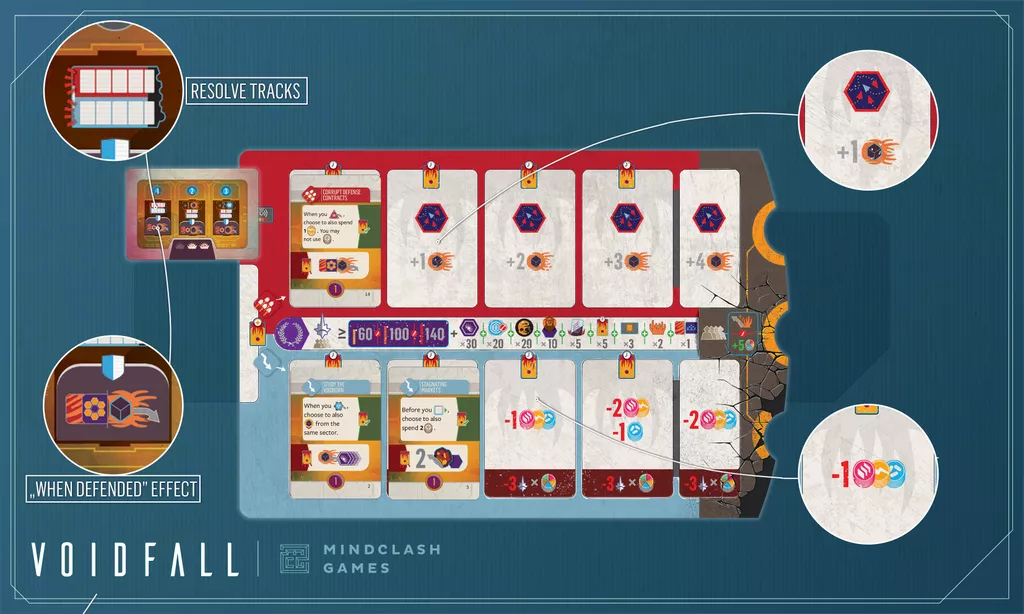
So now, when a War card triggers, it’s not merely triggering a Skirmish, it is telling you to resolve the current military and economic situation. The military situation shows a Skirmish with 1 additional strength (beyond the normal 1 strength per corruption on your player board), which you must resolve at the end of your turn; after which you look at the economic situation and you must pay one material, energy, and science (or lose a lot of influence). And if you didn’t lose a sector the “when defended” effect of the War card will resolve - this is a benefit on easier levels and in earlier Cycles, and a penalty (like the Voidborn reinforcing nearby sectors, see the example image) on higher difficulties or later Cycles.
This new structure of the War cards allowed us to remove the annoying rule of “don’t forget to pay at the end of every turn”, and allowed the players to focus on what’s important once again. So now you know what you need to face each turn to not lose, what do you need to do to win?

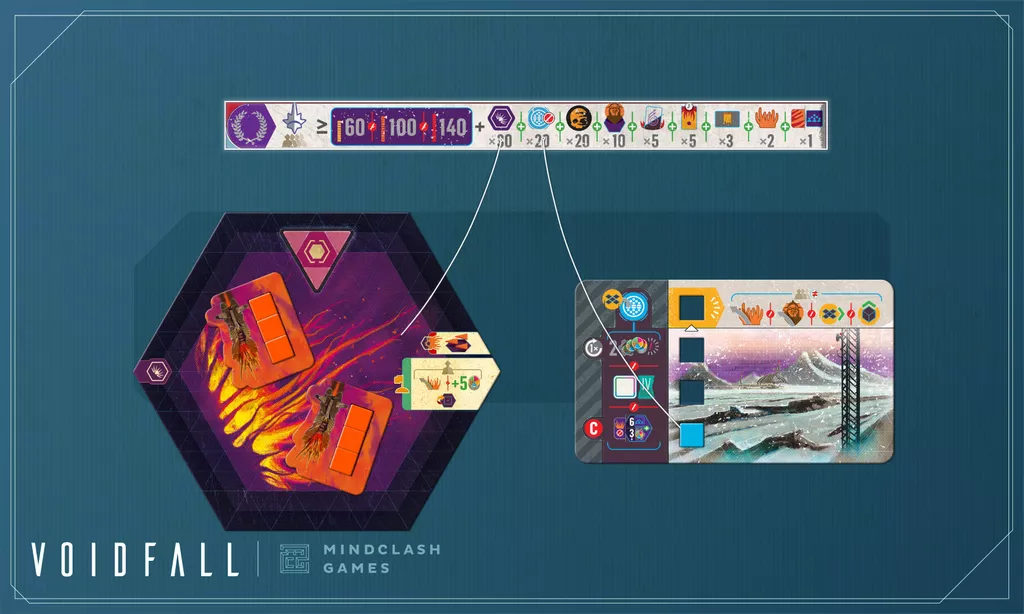
To win, you do your usual play of scoring Agendas and climbing Civilization tracks - but to make victory attainable, you have to lower the Voidborn’s score to a level you can reach yourself. Avoiding too many Catastrophes is a good beginning, but the most points the Voidborn gains are from open Rifts and unfinished Safe Havens. Rifts are the central hexes to the Voidborn’s empire, usually on the other side of the map compared to your starting hexes, so a grand military strategy’s goal is to have enough fleet power and enough invade actions to be able to invade all such sectors - some maps have 3 of them! During playtest we got a lot of feedback, that while it is very doable to score high using economic strategies (overproduction, specialized Agendas, highly developed sectors, rushing the Civilization tracks, etc) while maintaining a small empire and ignoring military expansion, it felt less satisfying - and also harder, because it did not come with a hard to reach anti-Voidborn achievement that would reduce the Voidborn’s score if successful. Enter the Safe Havens: thematically hidden backwater planets, where the civilian refugees are fleeing from the core sectors. They need our resources and our protection. If during your turn you overproduce two or more times, you may take one of your inactive fleet power cubes and place it on one of the available places of a Safe Haven tile. You can also do this once, maybe twice in a game when one of your Civilization tracks reach the top (Tier 4), and you can also do it in each Evaluation Phase - once for each pure sector you control with 3+ guilds and 6 population.
Once every space on a Safe Haven is filled (similarly to when a Rift is closed) players receive a reward - a small reprieve in return for their heroic efforts, and they can rest easy knowing that their valiant contributions will ensure an easier final target score.
Now you know what new goals of victory have entered your field of view, let’s take a look at the tools at your disposal.

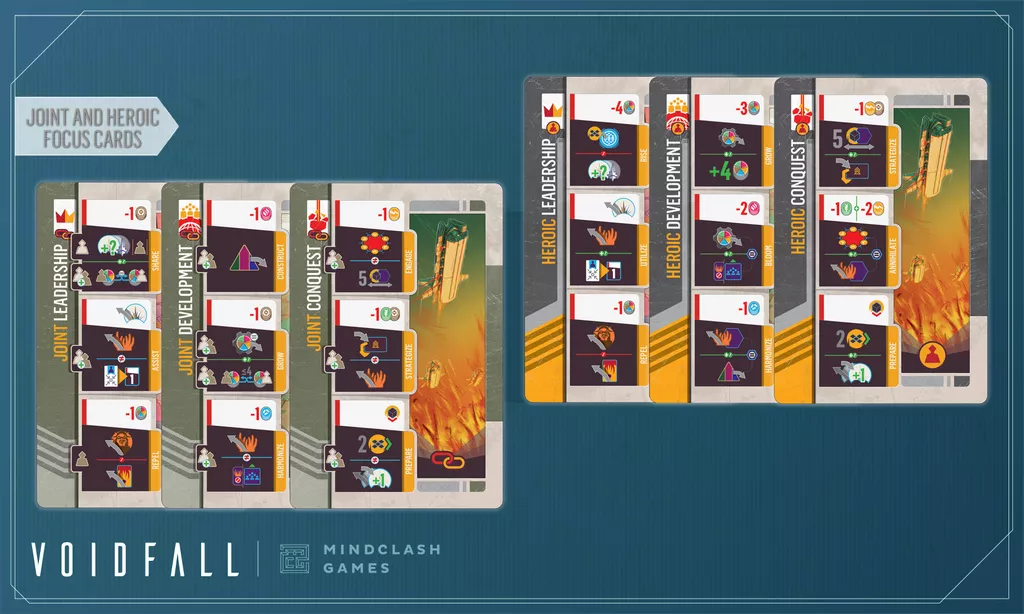
We knew we wanted the concept of Joint Focus cards. Last year we showed them as a sort of upgrade that allowed players to cooperate. We knew this wouldn’t work in solo, after all why waste an action, to give yourself roughly one action more’s worth next Cycle? So we tried it with a rule where in solo you could just play a Joint Focus instead of your usual one, but they don’t get to keep them for future Cycles. (Well first we tried “on top of”, thinking the poor solo player needed all the help, but when one of our playtesters doubled the highest ever recorded score, we quickly abandoned that approach…) After a while, we got very interesting feedback: in solo, they used Joint Focus a lot when it helped them, but it was weird (they had to re-interpret what “you and another player” means), and sometimes resulted in the same thing as their normal Focus, maybe cheaper. Meanwhile, in multiplayer, they desperately wanted to use the amazing Joint Focuses to be able to take one for the team and help each other, but they never had the spare turn to play Leadership Focus (a special multiplayer coop-only card at the time) to gain them.
So we realized, the solo method of gaining the card for an immediate “big boom” is the way to go for multiplayer, but we can’t just give the solo player the multiplayer “cooperating” cards, and expect them to have fun with it. Enter the Heroic Focus cards. We reduced the Joint Focuses to 10 (one of each normal Focus plus a Leadership), and said that you can play a Joint Focus instead of a matching regular Focus (i.e. if you play Joint Conquest, you cannot play Conquest this Cycle, while you could discard any Focus to play Joint Leadership), and still only three cards were available on offer each Cycle. Then, we created a second deck of ten cards (same composition), the aforementioned Heroic Focuses, that worked using the exact same rules, but their effects were all about helping the lone solo player “plug their gaps” or “firefighting” instead of enabling cooperation. This way, you don’t have to learn two sets of rules for the special Focuses, and you are not asked to use a set of effects in solo that were clearly not designed with you in mind.
And since only three Heroic/Joint Focuses are available each Cycle, and they may or may not overlap with your rough plan of which Focus cards you were gonna play (or what Agendas you need to match), this suddenly becomes a choice of opportunity costs and timing, instead of having to invest precious actions for benefits that may never come. I’m happy to say the system got simpler, people used it more, and the bespoke solo and the bespoke multiplayer cooperative experience both got better for it.
I hope you enjoyed this update to the inner workings of the solo and the cooperative mode of Voidfall, and you are reassured in the knowledge that we’re treating both this and the competitive modes as equal “first-class citizens”. Of course, this article is no substitute for the complete rules, but if you have any high level questions about the gameplay ask away. Thank you for reading, and beware of the Harbingers!